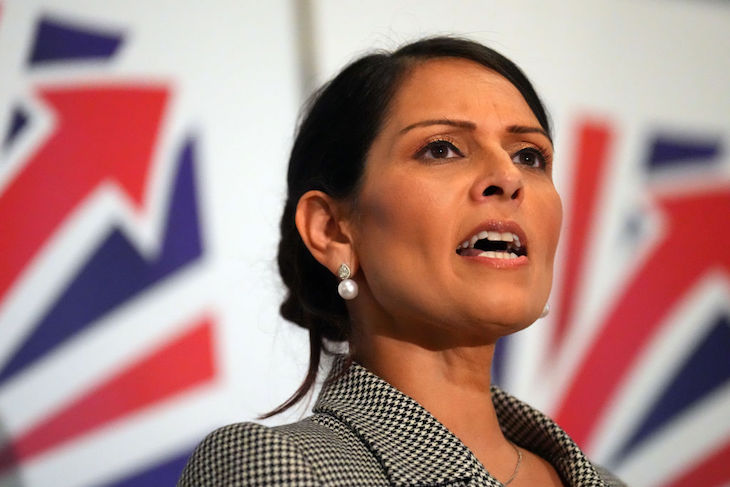Jonathan Gullis is a happy man. ‘Good news!’ the ex-Tory MP for Stoke-on-Trent North wrote following reports that Priti Patel, the former Home Secretary, is to run for the Tory leadership. ‘Priti can unite the Conservative Party, take the fight to Starmer’s Labour, and win back the trust of voters’, Gullis claimed. That’s quite the prospectus, for a party in such a shattered state. If reports in the Daily Telegraph are correct, Patel has been ‘urged to run’ by fellow MPs and already has ‘a campaign team funded by ‘high-profile Tory donors”. She plans to launch her bid for the top job by the end of next week.
In standing by Boris Johnson to the last, Patel co-owned his failures
Patel has obvious virtues. She is one of the few Tory MPs left with senior cabinet experience, a healthy majority, and a public profile who hasn’t been tainted by the psychodrama of the last two years. Having sat out the governments of Liz Truss and Rishi Sunak, Patel can present herself as a clean break. A self-described ‘massive Thatcherite’, she will appeal to those worried that the Conservatives haven’t been conservative enough.
Patel has gone out of her way to tickle the bellies of frustrated party members. She spoke at the first conference of the Conservative Democratic Organisation last year and called Tory members ‘the heart and soul of our party’ who ‘should never be taken for granted’. She was also at the launch of the Truss-aligned Popular Conservatives, with reports suggesting she was their preferred leadership pick.
Yet all this glad-handing appears to have done Patel’s leadership hopes little benefit. Having only 121 Tory MPs at least means a smaller number of MPs to be won over to reach the final two. But Patel would then need to secure the backing of a majority of party members, and she is hardly flavour of the month. The latest ConservativeHome survey had Patel in sixth, on only three per cent of the vote.
Other surveys also have the ex-Home Secretary lagging behind. YouGov has her ranked as only the thirteenth most popular Conservative politician in Britain. Hardly the most glittering accolade currently available in British politics, but it should give Patel pause for thought. What is it that other candidates – like Kemi Badenoch, James Cleverly, or Robert Jenrick – have that she does not?
Even if few Tory ministers have emerged with their reputations enhanced from the last few years, Patel has a particularly disappointing record from her time in government. She had a loose relationship with the ministerial code, resigning as International Development Secretary after unauthorised meetings with the Israeli government, and was involved in a bullying row with her former Permanent Secretary.
While no Home Secretary has it easy, Patel has been criticised for her response to the murder of Sarah Everard, and for a ‘Homes for Ukraine’ scheme for refugees so chaotic that it had to be handed over to Michael Gove. But where Patel really lost the trust of Tories is over immigration – both legal and illegal.
It would be no exaggeration to say that, under Patel, the Home Office lost control of immigration and let numbers explode. In 2019, the year Patel became Home Secretary, net migration ran at 184,000 – still higher than anything Britain had experienced before Tony Blair came to office. But that was dwarfed by the figure for 2022, the year she left the Home Office: 764,000. What the hell went wrong?
After all, the Conservatives were elected in 2019 on a pledge not only to introduce an Australian-style points system for immigration, but to bring overall levels down. Millions voted to leave the European Union not only to control migration, but to see it reduced. The failure to meet that pledge was the number one driving factor for Conservative voters switching to Reform on 4 July. Patel is to blame.
Well – Patel, and Boris Johnson. Despite talking a good game on migration control, Johnson’s Home Secretary was complicit in his shift to a much looser migration system, including through the scrapping of the migration target, the junking of the £30,000 minimum salary of threshold, and the loosening on the requirements for overseas students. The impact of all these policies was not hard to guess.
While presiding over this historic unbuttoning of legal migration routes, Patel also proved powerless in stopping the small boats crisis. As Patrick O’Flynn highlighted on Coffee House in 2021, despite pledges to make cross-Channel migration ‘totally non-viable’, to ‘make illegal migration no longer worth the risk’, and ‘smash the economic model of the people smugglers’, the boats continued.
In her last months in post, Patel also helped come up with the Rwanda scheme. Despite the best efforts of her successors, that farrago proved far more successful in lining the country’s president Paul Kagame’s coffers than it did in getting any illegal arrivals to Kigali. There was little sign that Patel had any plan for dealing with legal resistance to the scheme here or in Brussels. Her overall migration record is rather underwhelming.
Had Patel resigned on a point of principle when Johnson pushed for a looser system, she might have retained credibility. Jenrick did so with Rishi Sunak a year later. But in standing by Johnson to the last, Patel co-owned his failures. It’s no surprise that she left the cabinet at the bottom of ConservativeHome‘s league table.
However talented the campaign team that Patel has stitched together, they will struggle with her unpopularity amongst Tory members. More than any other figure of the last government, she embodies the Conservative party’s trust-breaking habit of promising migration reduction while delivering the opposite. Until she can reckon with that legacy, her hopes of becoming our next leader look slim.
Watch more like this on SpectatorTV:








Comments